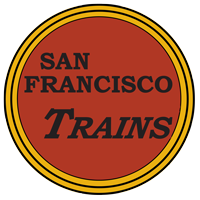The Reign of Steam
By 1922, operations were in full swing at Bayshore. The sheer magnitude of these operations are illustrated by the following excerpt from Southern Pacific’s company newsletter, the SP Bulletin:
One of the busiest points on Pacific Systems is the Bay Shore trainyard five miles “down the peninsula” from San Francisco, according to figures on the number of cars handled during the month of October, when a total of 41,918 fright cars were handled in these yards. All freight destined for San Francisco reaches Bay Shore yards where it is checked and the cars switched to various “drags” destined to different points in San Francisco. All outbound freight trains, likewise, are made up at Bayshore. Cars for the various freight trains scheduled to leave Bay Shore are sent to this point from from various points in San Francisco where they are checked and made up. The immense size of the Bay Shore yards can be realized from the fact that there are 25 outbound tracks and 39 inbound tracks, representing a total of 42.5 miles of trackage. In addition to handling the inbound and outbound freight traffic the Bay Shore yards also handle the daily switching of the 21 repair tracks at the Bay Shore repair shops, as well as of the various spur tracks of private industries in the Bay Shore district. For the convenience and efficiency in the handling of freight cars the Bay Shore train yard is second to none west of Chicago and possibly in the United States.
“Heavy Business at Bayshore,” SP Bulletin, January 1922
The following figures show the amount of freight business handled at Bay Shore during October, 1921: Cars received from the Western Division, 5324; cars received from the Coast Division, 3982; cars received from South San Francisco, 1602, cars delivered to the Western Division, 4839, cars delivered to the Coast Division, 4488, cars delivered to South San Francisco, 1258, cars sent to San Francisco in drags, 10,240, cars received from San Francisco, 10,185. Total freight cars handed through yard office Bay Shore 41,918. Total number of Switch engines operated in the yard per month, 422.
We don’t have data like this for subsequent years, but aerial photos from early 1930 suggest that both the Yard and Roundhouse were still seeing plenty of traffic at the onset of the Great Depression. Bayshore’s baseball team (yes, they had an official baseball team!) was mentioned frequently in the Bulletin throughout the Twenties. Otherwise, life at Bayshore seemed to be business as usual during this period.
As alluded to in the previous paragraph, Southern Pacific was able to weather the initial stock market crashes in late 1929. The railroad couldn’t outrun the slump forever, though, and carloads had tanked systemwide by the middle of 1931. Activity at the Roundhouse probably decreased as well. A mass purge of old motive power from SP’s roster in the beginning of 1934 kept the Shops busy for a time with scrapping work; records for many locomotives show them meeting their end at Bayshore during this period.

Coming out of the Depression, Bayshore’s locomotive facilities were due for a few upgrades. The original 80-foot turntable was replaced with an 110-foot one in 1943. Formerly a 100-foot turntable at Bakersfield that had in turn been replaced, SP lengthened it an additional 10 feet for its new installation at Bayshore using salvaged hardware from a bridge over the Pajaro River.

The Roundhouse itself saw some modification as well. Massive cab-forward articulated locomotives were spreading out from their original home on the Sacramento Division to the Coast Division, and these locomotives were so long that they wouldn’t allow the turntable-facing stall doors to be shut. At some point, the backs of stalls 36 and 38 were cut out and replaced with doors (stall 37 led to the Backshop and already had a door out the back) to accommodate them.

Diesel switchers began appearing on Southern Pacific’s locomotive roster in 1939. They quickly began proving their worth in maintenance cost savings, and although diesels for mainline passenger and freight would need to wait until 1947, SP’s management had decided by the close of World War II to pursue full dieselization. The days of steam were numbered.
Bayshore Roundhouse was slow to feel this change, as most dieselization efforts were focused on divisions elsewhere on the SP system. In fact, many displaced steamers from those divisions were reassigned to places like Bayshore to run out the rest of their useful miles for the company, keeping the steamer population steady even as retirement accelerated. Retirees were sent to a track in the Yard that came to be known as the “Dead Line” to await disposal by scrapping or sale, oftentimes for years.
As late as 1953, steam locomotives still held an overwhelming majority at the Roundhouse and received heavy repairs in the Shops. Bayshore could not hold back the tide of dieselization forever, though, and when the end came, it came suddenly. The Coast Daylight was abruptly dieselized in 1955, regular steam-powered freight ceased in late 1956, and steam on the Peninsula Commute went out with a bang in the form of January 1957’s “Farewell to Steam” train. Some steam locomotives would persist on the roster and in the Dead Line for a few more years, and a handful would pull excursions into 1958, but their reign was at an end.
